How To Repair Stone Veneer
Updated for 2020!It's been about five years since I wrote this series about the faulty installation of manufactured stone veneers, and the havoc information technology is causing unsuspecting homeowners. I decided information technology was fourth dimension for some new information and then I've updated things with new images and information.
It's all the rage these days: False stone siding,manufactured stone veneer, stone veneer, cultured rock,or any you choose to call it. I personally stick with the term, manufactured stone, or but stone veneer for short.
The product is used equally an accent on the front of a house (or it can be the whole siding in some cases). With it, you can give your habitation that mount cabin look, right here in suburbia.
Manufactured Stone Veneer (orAdheredConcrete Masonry Veneer or Adhered Manufactured Rock Veneer, as it's technically known) is a sparse, human being-made siding made to await similar natural stones or rocks.
It'southward basically molded concrete that looks like existent stone.
Stone veneer is normally installed over the wood framing on a dwelling. Merely when installed incorrectly, information technology will let water in adjacent to your forest framing, trap it, and wreak havoc on the structure of the house. And then far, I've yet to see an install done correctly in Louisville, Kentucky (or anywhere for that matter).
LEAKING MANUFACTURED Rock VENEER CREATES Wet Bug
In 2012, I was called in by a homeowner here in Louisville, Kentucky, to await at his two-year-sometime custom-built home.
The family unit had tried to hang drape rods on the front end wall, and they discovered that their drywall was too wet and mushy to hold a plastic wall anchor.
They had no clue as to why things were moisture. I was able to rail the problem downwardly to the manufactured stone veneer siding on the front of the firm.
The builder had omitted all of the of import flashing details with the install.
That solar day was the beginning of a 2-year fight betwixt the homeowner and his builder. During that entire period, his dining room was blocked off and unusable because of the extensive wood rot and mold problems that came along with information technology.
The event: Attorneys were hired and things got ugly. The architect eventually repaired all of the water damage, stripped all of the manufactured rock off the home, and replaced it with existent stone (they did not endeavour to install manufactured stone again).
The final price of the repair was close to $80,000.00.
Moisture intrusion experts take made a connection betwixt manufactured stone veneer and traditional stucco (stucco homes in Louisville, Kentucky are very rare to observe).
When problems arise from a botched install, a house with manufactured stone veneer shows the same moisture-related bug equally a house with a botched stucco organisation. Water leaks backside the cladding and gets trapped.So, the business firm rots.
In fact, one of the brightest minds in the earth of building science, Dr. Joseph Lstiburek refers tomanufactured stone veneer every bit "lumpy stucco." He has a great commodity that you can read here: Stucco Woes.
Near manufacturers ofASMV are members of theMasonry Veneer Manufacturers Association orMVMA, who are at present under theNCMA (National Physical Masonry Association). I know, plenty with the acronyms already.
The MVMA puts out an installation guide that is considered the "end-all-be-all" of how-to installation guides when it comes to manufactured stone veneer siding. When I am performing home inspections in Louisville KY, I refer to that guide and its details to show my clients how things should be done.
The problem is that I have never seen a home that has manufactured stone installed as the guide says information technology should exist. Almost every detail is commonly skipped–and we all know that the devil is in the details. You can download the MVMA guide here.
IDENTIFYING MANUFACTURED STONE VENEER
I've had a number of domicile inspectors and homeowners write to me over the years and enquire, "Is this manufactured stone?" Let's have a expect at the means you can make up one's mind if your cladding is manufactured rock.
Manufactured Stone Veneer Installs:
- Have cutting edges on the stones. Most MSV installs will accept at least a few stones that accept been cut to fit into the wall. Look for those pieces. Unremarkably, yous can see the small pebbles in the casting from the manufacturing procedure. Come across the epitome below where I moisture the edge to accept the pebbles show up more clearly.
- Manufactured Stone Veneer will be stuck to the surface of the wall, hence the technical proper noun of AMSV (Adhered Masonry Rock Veneer). You should exist able to run into the manufactured stone veneer pieces cease a few inches in a higher place the grade (soil or mulch). The reality though, is that it hardly ever does.
- Just almost any edifice constructed in the past thirty years volition utilize manufactured stone as opposed to real rock. It's but too costly to use real stone or even real stone veneer. There are some exceptions, but more often than not, this rule holds truthful.
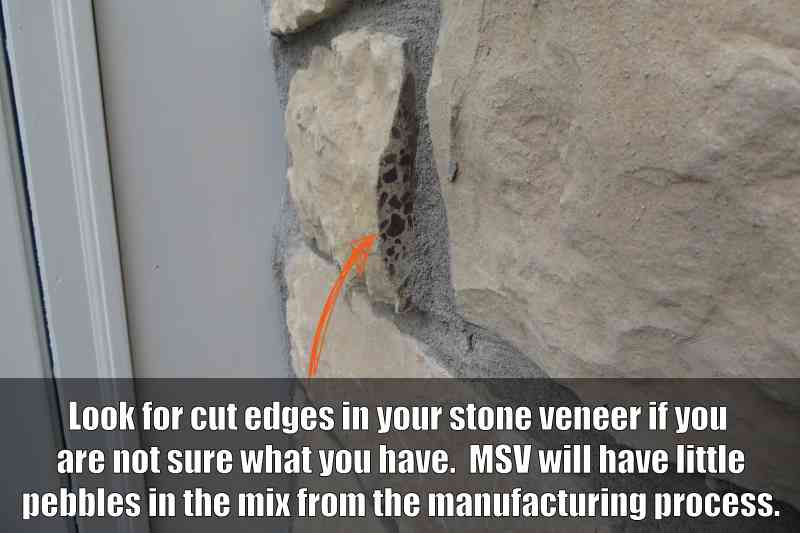
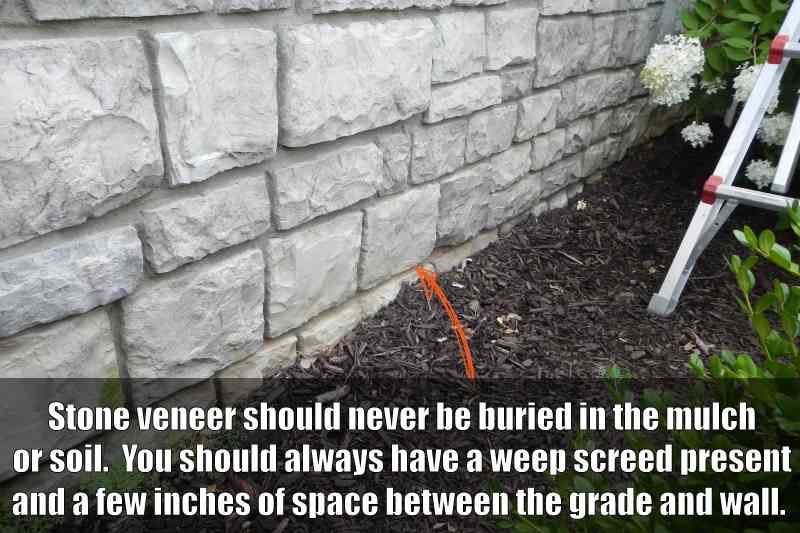
MOISTURE INFILTRATION WITH MANUFACTURED Rock VENEER
A wise man once told me that water and women can be lumped into the same category: They both always win.
Never is that statement more true than when it comes to the manufactured rock installation on your home. Water will find a way in.
It will seep in around the cracks, and information technology will be absorbed into the mortar and chunks of concrete. You didn't retrieve this stuff was waterproof, did you? It's colored concrete. It absorbs the rainwater, the sprinkler h2o, melting snowfall–everything.
What nosotros must exercise as construction professionals is design and build a wall organization that can control the h2o and not let it achieve the structural framing of the firm.The moisture will go by the rock veneer; it's what happens adjacent that is vital to the integrity of your house.
Every type of siding (or cladding) needs to be able to drain the moisture that gets by it.
Have brick veneer for example. Building codes take required a 1″ gap (brick manufacturers recommend a two″ gap, by the style) betwixt the capsule on a business firm and the behind of the brick.
When the water gets absorbed past the brick (No, brick veneer is not waterproof either), that gap is in place to make sure the h2o doesn't soak the wood framing backside information technology. Information technology gives the moisture a path to escape at the base of the wall, via weep holes.
Take a look at the brick wall detail below, and you'll see the drainage plane present. The air gap is the light-green-colored surface area. This allows the moisture a path to escape, and more importantly, a decoupling of the brick and woods then that capillary activity cannot describe the moisture into the wood framing.
I wrote an article nigh a home with a failed stone veneer and a failed brick weep organisation that acquired catastrophic damage that you can read hither (Failed Manufactured Rock and Brick Veneer on New Construction Dwelling.) If you would like to come across what the inside of a brick wall cavity looks like, you lot tin can get a general thought with this video I shot of a brick veneer wall assembly. Video of Brick Veneer Wall Assembly
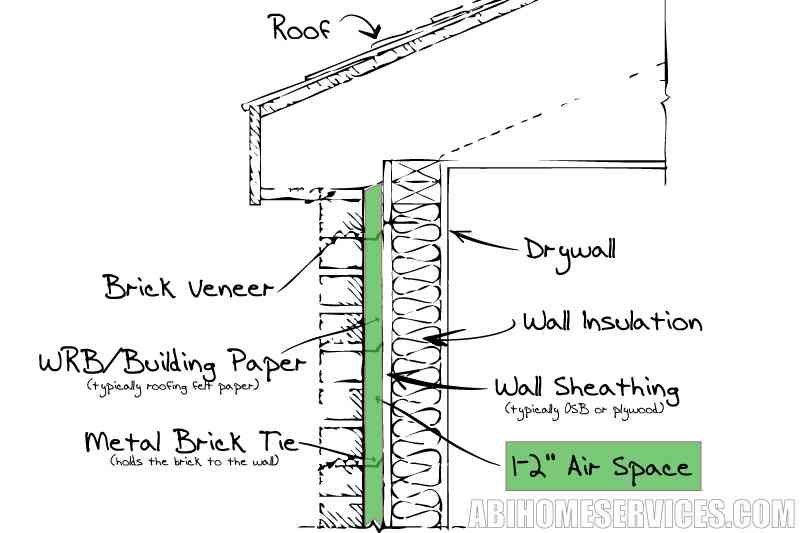
FLASHING DETAILS Brand OR Pause MANUFACTURED STONE VENEER
Manufactured stone veneer is typically installed on top of the wood sheathing on a business firm. It doesn't have an air gap since it'southward adhered or stuck to the wall, and is non resting on the foundation wall (similar brick veneer).
If you want a problem-free install of manufactured stone, you must create a path for moisture to drainand a identify for information technology to escape at the base of the walls, windows and doors.
If y'all do not have a drainage point, the moisture volition simply build up and rot out the base of the structure. I've never seen a abode with an escape betoken, (known as aweep screed) installed, and I look at new construction homes every week. The builders are just not installing it.
In the wall detail beneath I've highlighted the cry screed in ruddy at the base of operations of the wall. This pocket-sized slice of flashing will permit any moisture that has built up backside the manufactured stone a identify to bleed and will let fresh air an entry point to dry out things out.
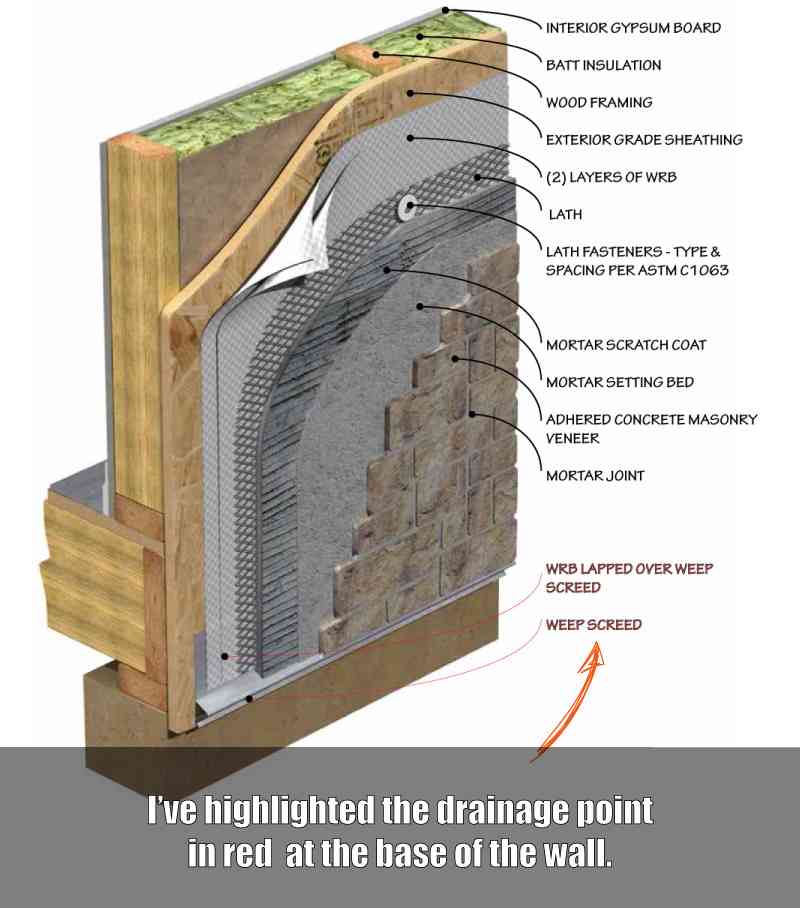
PROPER INSTALLATION OF MANUFACTURED Rock VENEER SIDING
Hindsight is always 20/twenty, and now that the issues with manufactured stone are coming to low-cal, we're getting smarter almost it from an engineering standpoint. Unfortunately, the installation on homes is all the same all messed up.
If you actually read the whole MVMA install guide, (You did read information technology, correct?) you'll see that at the terminate of the document in that location are culling methods for building the manufactured stone veneer wall system.
These include adrainage mat or furring strips mounted to the sheathing of the wall. Past adding these details, y'all volition essentially create an air gap between the house and the concrete veneer. Audio familiar? That air gap will allow for moisture command and drainage to occur without the hazard of the moisture soaking into the woods structure of the home.
"Is anyone doing this?" you lot ask.
They're not doing it here in Louisville, or anywhere else I've been to inspect manufactured rock veneer installations.
It's likely going to take some really large lawsuits to become the ball rolling on correct installs. The process requires more planning, more work, and careful execution to pull off.
Below is a item for the use of a drainage mat used in identify of the furring strips. This method also creates that needed air gap betwixt the manufactured stone layer and the structure of the habitation.
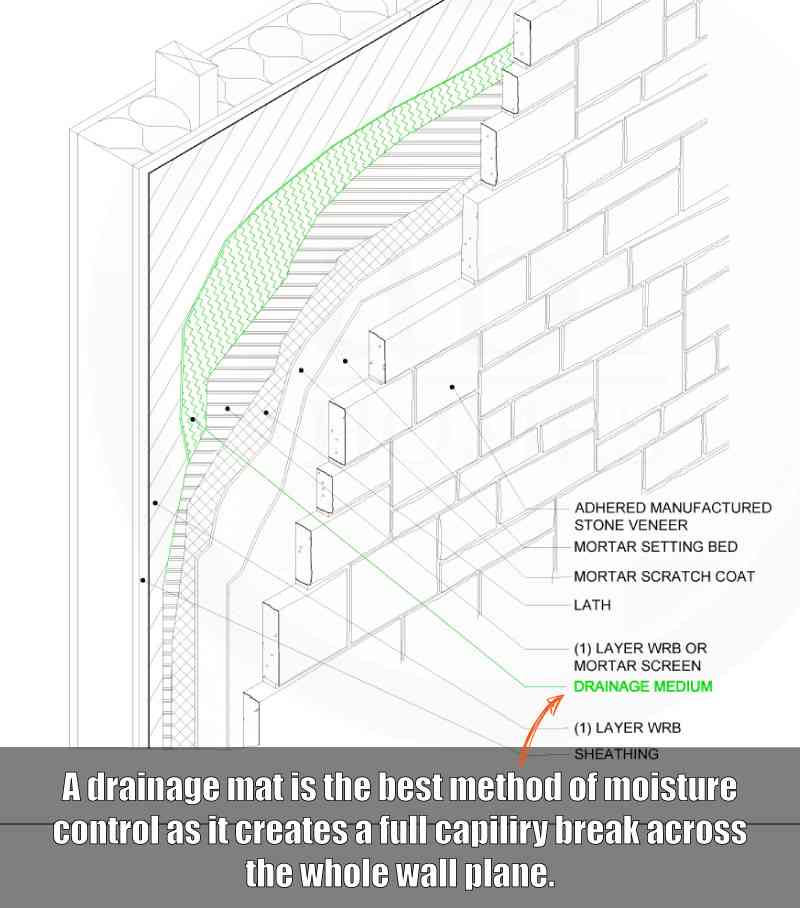
INSPECTING YOUR HOME FOR MANUFACTURED STONE Bug
If you accept this material on your dwelling and have questions experience free to contact me.
More than likely, your dwelling's manufactured rock veneer was poorly installed.
I hate to say information technology, simply I've never inspected a house that had a proper install. In that location are ways to take minimally invasive moisture readings from the inside and outside of the domicile to get a better idea of what blazon of damage may be occurring in your home.
If y'all'd like more information on this process, only give me a call and we can talk. I accept traveled extensively to help clients with manufactured stone issues, so don't recollect that just because you are not in the Louisville, KY area I tin't help.
When big issues pop up with a house, we can normally trace their origins back to a bunch of small-scale details that add up to the current train wreck.
That seems to be the reoccurring theme with the manufactured stone installations that I am seeing now. When the dwelling is missing all of the critical flashing details like weep screeds, kick-out flashing, and casement beads, how can one assume the associates volition perform OK?
Anyone who'due south ever spent fourth dimension on a job site knows the mental attitude of well-nigh construction workers today. Over the many years I've worked in the trades, one of the more popular things to hear was, "Looks good from my house," or "We ain't edifice a piano."
That's a creative style of saying they but don't intendance. They do not care if you have problems later. If it'southward 'skillful enough' to get things cleared, and if it's 'good enough' to get them paid, let it coil.

Ben in Forbes!
I had the honor of beingness interviewed for an article in Forbes.com about my work with manufactured stone veneer inspections. You tin can read that hither.
Source: https://abihomeservices.com/manufactured-stone-veneer-moisture-problems/
Posted by: hernandezbourponshave.blogspot.com


0 Response to "How To Repair Stone Veneer"
Post a Comment